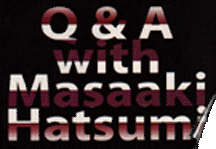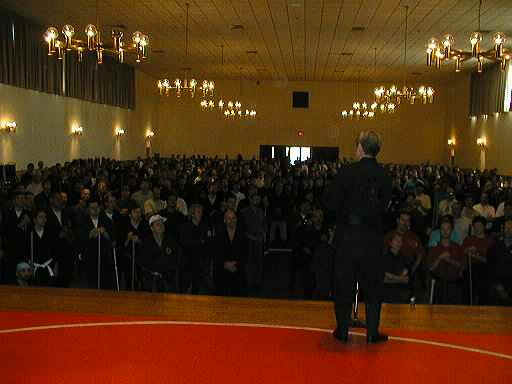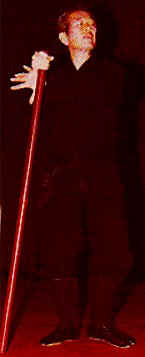|
Renowned Ninja Expert is Alive and Kicking -- and Tending His Flock
Interview by Josh Sager
June 1998 issue of Black Belt Magazine -reprinted with permission In the 1980s, the ninja boom hit the United States like a hurricane. It seemed like everyone wanted to learn how to throw smoke bombs and then disappear, how to infiltrate enemy fortresses, and how to don a black hood and sneak around in the dark.Almost overnight, numerous self-proclaimed grandmasters of ancient ninja sects seemed to come out of the woodwork for a chance at sharing the spotlight. While most of these"instructors" were striving to cash in on the booming sales of throwing stars and climbing claws, a few were content to practice their art and work toward perfecting the skills of their students. There were the people who ended up weathering the storm andsurviving into the 1990s. Masaaki Hatsumi is one of those ninja authorities, and themartial arts community still holds him in high esteem. The following interview was meant to let the world know what the ninja master has been up to. BLACK BELT: Its been almost 15 years since you started coming to the US to teach. What changes have you seen in the way Americans train? Masaaki Hatsumi: At the time I first came, there was a ninja boom. Everybody thought that Ninjutsu was something mysterious --something bad. And I have gradually corrected this. Ninjutsu is really a genuine martial art. That's the one reason why I changed the name from Ninpo Taijutsu to BudoTaijutsu. They are one and the same. Ninpo is a form of Budo Taijutsu.
At the 1997 US Tai Kai, Hatsumi (right) focused on
BB: How has the art evolved since Takamatsu Sensei passed it on to you? MH: It has not evolved. It's just alive. It has just survived. It's like two things being the same; they seem to be changing, but they are keeping the same form. Isomorphism. Many people talk about evolution, and there was a time when the theory of evolution was all the rage. But what is actually underneath human life has not evolved at all; it has not changed. That's why they have to train, they have to reflect on their own actions, they have to do penance. That's why I say, "What is adojo?" Its not someplace where you should aim to become strong. Its a place for penance, a place to reflect on what you've done. And to live like a true human being. So people shouldn't misunderstand what a dojo is about. They shouldn't have any illusions. A dojo isn't something with a concrete form. Every day is a dojo, wherever you are.
BB: How do you believe the practitioners of Bujinkan Budo Taijutsu are representing your art? MH: Jack [Hoban] is a perfect example. Ask him because he is far better at expressing the art in an American way than I am. You can't express it in Japanese in an American way. Jack will speak from his heart about the art --in an American way. Because in him you have the genuine article who will transmit to you my blessed teachings. So even when I am back in Japan, you can continue to ask Jack. BB: We often hear you say that the martial arts are about love and protecting life, yet the general perception of the arts is one of violence. How do you make the differentiation? MH: It's just the things that any normal,serious person has to do in life. If you study a martial art that's a bit strange, it's wrong. Then you become like a wild beast.
Despite his 66 years, Hatsumi (left) proves that
BB: Can you explain the reason why you hold a TaiKai event every year? MH: To allow people to know about my martial art a little better. That's why I travel around the world. BB: Why did you decide to add the 11th degree blackbelt to 15th degree black belt ranks to your system? MH: Its not something new. In the old days,it was like this. Its just that there weren't any 11th dan holders before. BB: In what direction do you see the art going in the future? MH: It doesn't matter if it doesn't develop further. It doesn't matter if there is only one good person in the art -- that's enough.If there is just one fine person, then that's the meaning. We don't need many people. It's like in America, where you have President Clinton -- just the one president. That's all we need. BB: What's the most rewarding aspect of teaching your art? MH: If people look at nature, they think it's beautiful. People who've go this genuine nature of humanity see something beautiful and say, "That's beautiful -- I want to protect it." And if you talk about the evolution of the martial arts, that's where the arts need to evolve -- with that kind of attitude. BB: Do you see any differences between how Ninjutsu is interpreted here in the US and how it's interpreted in the rest of the world? MH: It's the same. BB: What would you like the people who come to the Tai Kai to walk away with when it's over? MH: I would like people to leave behind all the bad [aspects] of themselves so their heart can become lighter.
Like any other martial art's
weapon, the jo should be
About the author: Josh Sager started taking martial arts when he was 4. Since then, the West Berlin, New Jersey-resident has trained in Tae-Kwon-Do, Kali, Jujitsu, and WingChun. He currently studies Ninjutsu. © 2016 Warrior Information Network. All rights reserved.
|




